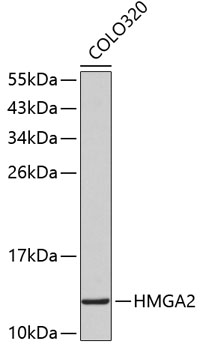Anti-HMGA2 Antibody (CAB2972)
- SKU:
- CAB2972
- Product type:
- Antibody
- Reactivity:
- Human
- Host Species:
- Rabbit
- Isotype:
- IgG
- Research Area:
- Cell Cycle
Description
| 抗体名: | Anti-HMGA2 Antibody |
| 抗体コード: | CAB2972 |
| 抗体サイズ: | 20uL, 50uL, 100uL |
| 申し込み: | WB |
| 反応性: | Human |
| 宿主種: | Rabbit |
| 免疫原: | A synthetic peptide of human HMGA2 |
| 申し込み: | WB |
| 推奨希釈: | WB 1:500 - 1:2000 |
| 反応性: | Human |
| ポジティブサンプル: | COLO320 |
| 免疫原: | A synthetic peptide of human HMGA2 |
| 精製方法: | Affinity purification |
| ストレージバッファ: | Store at -20'C. Avoid freeze / thaw cycles. Buffer: PBS with 0.02% sodium azide, 50% glycerol, pH7.3. |
| アイソタイプ: | IgG |
| 順序: | Email for sequence |
| 遺伝子ID: | 8091 |
| Uniprot: | P52926 |
| セルラーロケーション: | Nucleus |
| 計算された分子量: | 9kDa/10kDa/11kDa |
| 観察された分子量: | 13kDa |
| 同義語: | HMGA2, BABL, HMGI-C, HMGIC, LIPO, STQTL9 |
| バックグラウンド: | This gene encodes a protein that belongs to the non-histone chromosomal high mobility group (HMG) protein family. HMG proteins function as architectural factors and are essential components of the enhancesome. This protein contains structural DNA-binding domains and may act as a transcriptional regulating factor. Identification of the deletion, amplification, and rearrangement of this gene that are associated with myxoid liposarcoma suggests a role in adipogenesis and mesenchymal differentiation. A gene knock out study of the mouse counterpart demonstrated that this gene is involved in diet-induced obesity. Alternate transcriptional splice variants, encoding different isoforms, have been characterized. |
| UniProt Protein Function: | HMGA2: Functions as a transcriptional regulator. Functions in cell cycle regulation through CCNA2. Plays an important role in chromosome condensation during the meiotic G2/M transition of spermatocytes. Interacts with E4F1. Interacts with NEK2. Belongs to the HMGA family. 2 isoforms of the human protein are produced by alternative splicing. |
| UniProt Protein Details: | Protein type:DNA-binding; Oncoprotein Chromosomal Location of Human Ortholog: 12q15 Cellular Component: nucleoplasm; nuclear chromosome; nucleus Molecular Function:protein binding; nucleosomal DNA binding; DNA-(apurinic or apyrimidinic site) lyase activity; DNA binding; AT DNA binding; DNA-dependent protein kinase activity; 5'-deoxyribose-5-phosphate lyase activity; SMAD binding; DNA bending activity; transcription factor binding Biological Process: fat cell differentiation; establishment and/or maintenance of chromatin architecture; positive regulation of apoptosis; multicellular organismal development; positive regulation of transcription, DNA-dependent; mesodermal cell differentiation; negative regulation of transcription from RNA polymerase II promoter; regulation of transcription, DNA-dependent; base-excision repair; regulation of growth; chondrocyte differentiation; negative regulation of retroviral genome replication; mitosis; transcription, DNA-dependent; heterochromatin formation; response to virus; DNA damage response, detection of DNA damage; stem cell differentiation; DNA catabolic process, endonucleolytic; negative regulation of DNA binding; chromosome condensation; mesenchymal cell differentiation; cell division; mitotic cell cycle G2/M transition DNA damage checkpoint; chromosome breakage; epithelial to mesenchymal transition; positive regulation of transcription from RNA polymerase II promoter; negative regulation of transcription, DNA-dependent; negative regulation of apoptosis Disease: Leiomyoma, Uterine |
| NCBI Summary: | This gene encodes a protein that belongs to the non-histone chromosomal high mobility group (HMG) protein family. HMG proteins function as architectural factors and are essential components of the enhancesome. This protein contains structural DNA-binding domains and may act as a transcriptional regulating factor. Identification of the deletion, amplification, and rearrangement of this gene that are associated with myxoid liposarcoma suggests a role in adipogenesis and mesenchymal differentiation. A gene knock out study of the mouse counterpart demonstrated that this gene is involved in diet-induced obesity. Alternate transcriptional splice variants, encoding different isoforms, have been characterized. [provided by RefSeq, Jul 2008] |
| UniProt Code: | P52926 |
| NCBI GenInfo Identifier: | 1708263 |
| NCBI Gene ID: | 8091 |
| NCBI Accession: | P52926.1 |
| UniProt Related Accession: | P52926 |
| Molecular Weight: | |
| NCBI Full Name: | High mobility group protein HMGI-C |
| NCBI Synonym Full Names: | high mobility group AT-hook 2 |
| NCBI Official Symbol: | HMGA2 |
| NCBI Official Synonym Symbols: | BABL; LIPO; HMGIC; HMGI-C; STQTL9 |
| NCBI Protein Information: | high mobility group protein HMGI-C |
| UniProt Protein Name: | High mobility group protein HMGI-C |
| UniProt Synonym Protein Names: | High mobility group AT-hook protein 2 |
| Protein Family: | HMG2-induced ER-remodeling protein |
| UniProt Gene Name: | HMGA2 |
| UniProt Entry Name: | HMGA2_HUMAN |


